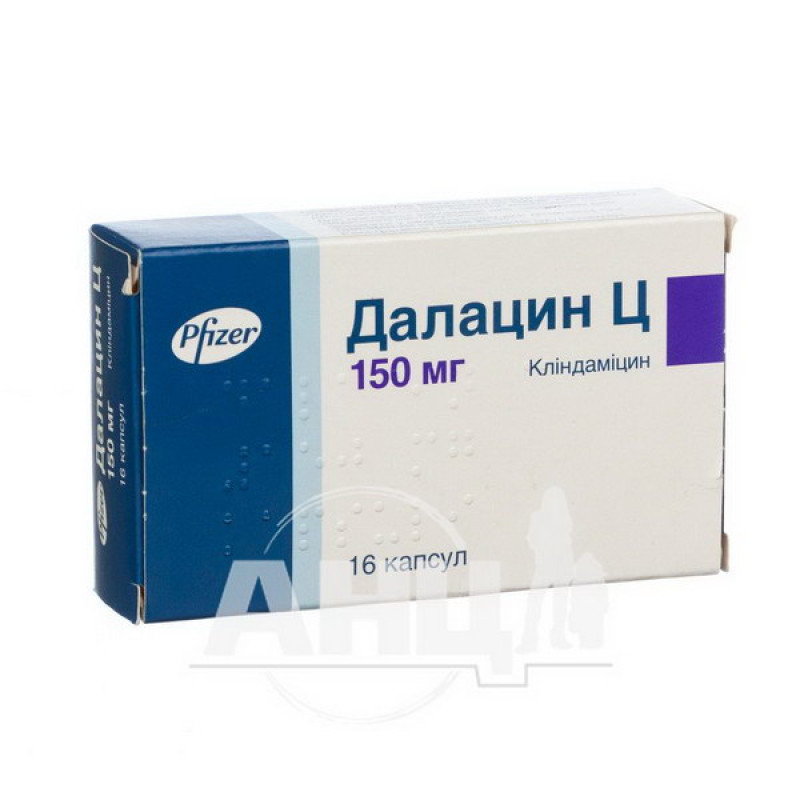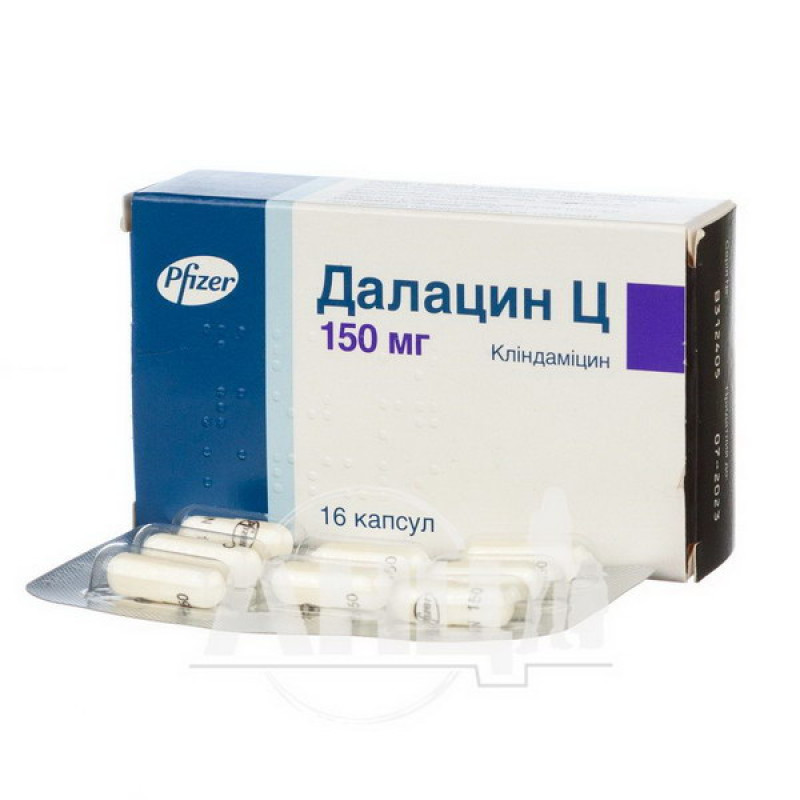Dalacin C capsules 150 mg blister No. 16

Dalacin C is indicated for the treatment of acute and chronic bacterial infections caused by microorganisms sensitive to clindamycin, including:
bone and joint infections; ear, nose and throat infections; tooth and jaw infections; lower respiratory tract infections; pelvic and abdominal infections; female genital infections; skin and soft tissue infections; scarlet feverIn severe clinical conditions, treatment should initially be carried out with drugs containing clindamycin and slowly injected into a blood vessel (by injection).
Clindamycin belongs to the group of lincosamide antibiotics. The mechanism of action of clindamycin is based on the inhibition of protein biosynthesis by binding to the 50S subunit and affecting both ribosome assembly and the translation process. Although clindamycin phosphate is inactive in vitro, rapid hydrolysis in vivo converts it to the antibacterially active clindamycin. At usual doses, clindamycin exhibits bacteriostatic activity.
Composition
active ingredient: clindamycin;
1 capsule contains 177.515 mg of clindamycin hydrochloride, equivalent to clindamycin 150 mg
1 capsule contains 355.030 mg of clindamycin hydrochloride, equivalent to clindamycin 300 mg
excipients: corn starch, lactose monohydrate, talc, magnesium stearate, capsule shell 150 mg, titanium dioxide (E 171), gelatin;
capsule shell 300 mg titanium dioxide (E 171), gelatin, indigo (E 132), erythrosine (E 127).
Contraindication
Dalacin C should not be used in patients with known sensitivity to clindamycin, lincomycin or any other component of the drug.
Dalacin C is not suitable for the treatment of meningitis because the concentration of the antibiotic achieved in the cerebrospinal fluid is too low.
Method of administration and doses
Dalacin C should be taken with sufficient fluid (at least 1 large glass of water) to avoid possible irritation of the esophagus.
If an infection caused by β-hemolytic streptococcus is suspected or if there are signs of β-hemolytic streptococcus, treatment should be carried out for at least 10 days.
Capsules of 150 mg.
Adults. Depending on the location and severity of the infection, adults and children over 14 years of age should take 4-12 capsules per day (equivalent to 0.6-1.8 g of clindamycin).
The daily dose is divided into 4 doses.
To provide high doses, there are also medicines with a high content of the active substance.
Children.
Dalacin C capsules are not suitable for use in children who cannot swallow them whole. Capsules allow for accurate dosing of the drug in mg/kg, so in some cases it may be necessary to use the drug in another, more convenient dosage form.
Depending on the location and severity of the infection, children under 14 years of age should be given 8-25 mg of clindamycin per kilogram of body weight per day.
The daily dose is divided into 3-4 separate doses. As a rule, 4 doses are preferred.
Application features
Use during pregnancy
A large study of pregnant women exposed to clindamycin during the first trimester of pregnancy (approximately 650 infants) did not show an increased incidence of birth defects. However, there is insufficient evidence to support the safety of clindamycin during pregnancy.
The results of experimental studies in animals do not suggest any direct or indirect harmful effects on the course of pregnancy, embryonal/fetal development, the course of childbirth or postnatal development.
Clindamycin crosses the placenta. It is assumed that therapeutic, effective concentrations are achieved in the fetus. When using the drug during pregnancy, the benefits and possible risks associated with treatment should be carefully weighed.
Use during breastfeeding
Clindamycin is excreted in human milk. Clindamycin has been reported to be present in human breast milk at concentrations ranging from <0.5 to 3.8 μg/mL following systemic administration. Therefore, adverse effects on the gastrointestinal microflora of breast-fed infants, such as diarrhea or blood in the stool, sensitization, rash, and mucosal colonization with yeasts, cannot be excluded. Due to the risk of severe adverse reactions in breast-fed infants, clindamycin should not be used during breastfeeding.
Reproductive function.
Animal studies have not shown any evidence of impaired reproductive function. There are no data on the effects of clindamycin on human reproductive function.
The ability to influence the reaction speed when driving vehicles or other mechanisms.
Clindamycin has a mild to moderate influence on the ability to drive or use machines. Some adverse reactions may affect the ability to concentrate and react; therefore, they may affect the ability to drive or use machines.
Overdose
So far, no symptoms of overdose have been observed. If necessary, gastric lavage is indicated. Hemodialysis and peritoneal dialysis are not effective in removing clindamycin from the blood serum. No specific antidote is known.
The adverse reactions listed below have been identified during clinical trials and during post-marketing surveillance. Within each category, adverse reactions are presented by frequency and clinical significance.
Adverse reactions are classified according to frequency using the following convention: very common (≥ 1/10), common (≥ 1/100 to <1/10), uncommon (≥ 1/1,000 to <1/100), rare (≥ 1/10,000 to <1/1,000), very rare (<1/10,000), not known (frequency cannot be estimated from the available data). Adverse reactions are listed in order of decreasing seriousness within each category.
Infections and invasions.
Often pseudomembranous colitis.
Frequency unknown: Clostridium difficile colitis, vaginal infections.
From the blood and lymphatic system.
Often agranulocytosis, neutropenia, thrombocytopenia, leukopenia, eosinophilia.
From the immune system.
Rarely, drug fever.
Very rare anaphylactic reactions.
Frequency unknown: anaphylactic shock, anaphylactoid reactions, hypersensitivity.
From the nervous system.
Uncommon: taste perversion, neuromuscular blockade.
Frequency unknown: dizziness, drowsiness, headache.
From the gastrointestinal tract.
Very common: esophageal irritation, esophagitis, stomatitis, diarrhea, abdominal pain, nausea, vomiting.
Frequency unknown: esophageal ulcer.
Hepatobiliary disorders.
Very rarely, transient hepatitis with cholestatic jaundice.
Frequency unknown: jaundice.
On the skin and subcutaneous tissue.
Often maculopapular rash, crust-like rash, urticaria.
Rarely toxic epidermal necrolysis, Stevens-Johnson syndrome, Lyell syndrome, angioedema/angioedema, exfoliative dermatitis, bullous dermatitis, erythema multiforme, pruritus, vaginitis.
Very rare: rash and blistering, hypersensitivity reactions.
Frequency unknown: Drug reaction with eosinophilia and systemic symptoms (DRESS syndrome) Acute generalized exanthematous pustulosis
Musculoskeletal and connective tissue disorders.
Very rarely polyarthritis.
Interaction with other medicinal products and other types of interactions
Antagonism (induced resistance) has been observed in vitro between clindamycin and erythromycin in a subset of macrolide-resistant bacterial isolates. The two drugs should not be used concomitantly due to potential clinical significance, unless appropriate susceptibility testing has been performed.
Pathogenic microorganisms demonstrate cross-resistance to clindamycin and lincomycin.
Due to the inherent properties of the drug Dalacin C to block neuromuscular transmission, it may enhance the effect of muscle relaxants (e.g. ether, tubocurarine, pancuronium halide). This may lead to unexpected life-threatening situations during surgery. Therefore, Dalacin C should be used with caution in patients receiving the above-mentioned drugs.
When used simultaneously with Dalacin C, the reliability of the contraceptive effect of oral contraceptives is questionable. Therefore, during treatment with Dalacin C, other methods of contraception should be used in addition.
Vitamin K Antagonists: Elevated coagulation tests (prothrombin time/international normalized ratio) and/or bleeding have been reported in patients receiving clindamycin in combination with vitamin K antagonists (e.g. warfarin, acenocoumarol, and fluindione). Therefore, coagulation tests should be monitored regularly in such patients.
Clindamycin is metabolized by CYP3A4 and to a lesser extent by CYP3A5 to form the major metabolite clindamycin sulfoxide and the minor metabolite N-desmethyl-clindamycin. Thus, inhibitors of CYP3A4 and CYP3A5 may decrease clindamycin clearance, and inducers of these isoenzymes may increase clindamycin clearance. When potent inducers of CYP3A4, such as rifampicin, should be monitored for loss of efficacy.
In vitro studies indicate that clindamycin does not inhibit CYP1A2, CYP2C9, CYP2C19, CYP2E1, or CYP2D6 and only moderately inhibits CYP3A4. Therefore, clinically significant interactions between clindamycin and concomitantly administered drugs metabolized by these CYP enzymes are unlikely.
Storage conditions
Store out of the reach of children at a temperature not exceeding 25 °C.
Shelf life - 5 years.
There are no reviews for this product.
There are no reviews for this product, be the first to leave your review.
No questions about this product, be the first and ask your question.






